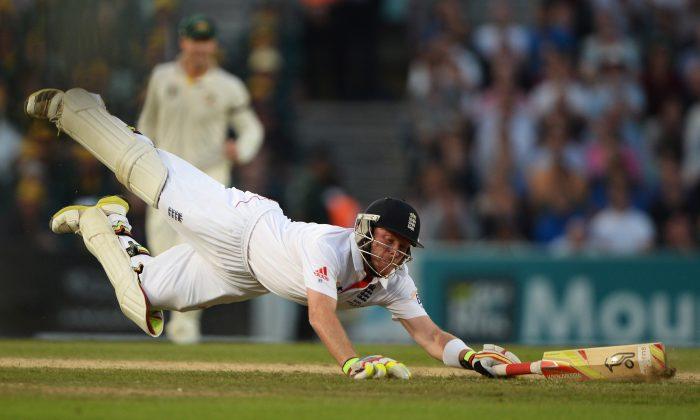The fifth Investec 2013 Ashes Test match between England and Australia at the Kia Oval ended in an abortive draw with England disappointed that they were not able to receive the final four overs to try to get the 21 runs they still needed to win the match, but judging by the events of the previous four days they really did not deserve the victory.
Somewhat dramatically the 2013 Ashes Series ended on a sour note however.
At the close of the series, while they should probably have been jubilant in celebration, England fans loudly booed the Australia captain during the trophy ceremony. But this was hardly the worst, as this type of behaviour is common to both countries’ crowds. It was late in the evening when proceedings turned their ugliest and England player’s celebrations went beyond decency, as they disrespected themselves and the pitch.
First innings
In what was forecast to be a rain shortened match and the 5-Test series already decided, England, with both bat and ball, seemed content to play slowly for a draw to the frustration of the visitors.
Australia had scored 492 runs in their first innings with a run-rate of 3.81 across the 128.5 overs that they had faced to set up a challenging chase for England. Shane Watson had scored 176 having faced 247 balls, when he was caught out by Kevin Pietersen off a Stuart Broad ball. Steven Smith’s 138 not out was also a highlight of the innings.
By contrast, England scored 377 at 2.60 runs per over in 144.4 overs.
Second innings
In an un-entertaining display, England had been playing so slowly during the match—for example, on the second day (Friday), their run rate was meandering along at less then 2 runs per over at one stage. But England were given a teasing chance to win and they took it.
In the second innings on the final day, Australia generously declared at 111 for 6 wickets and the match sprang into life. It had taken Australia 23 overs to make this score with a run-rate of 4.82.
Aiming to win the match, the Australian captain, Michael Clarke, made that spirited declaration at tea leaving England a target of 228 in a minimum of 44 overs—England needed to score at the rate of 5.18 runs per over.
To achieve such a total, at that run rate, was still expected to be difficult although the pitch had been rested the day before due to rain, it gave Australia an outside chance of winning the match with England chasing runs—980 runs had already been scored and 296 overs had been delivered on the pitch to that point.
England’s Alistair Cook scored 34, Jonathan Trott made 54, but it was the exceptional batting performance by Kevin Peitersen scoring 62 off 55 balls that put the home side on course for what looked to be a thrilling victory in the otherwise lacklustre match.
Tracking at 5.15 runs per over and closing on Australia’s now slender lead, England were thwarted by bad light requiring 21 runs to win with four overs left to bowl and four wickets remaining. England were understandably disappointed.
To continue the match might have given some final excitement to what was a pretty dour previous three and three quarter days of play (with the one day lost for rain). Instead the series ended in an anti-climax.
Although the outcome of the match was heading in England’s favour, it could have gone against them. At the same time, Australia appeared to be getting nervous of the final outcome and, expecting light to close in soon, appeared to reduce their over rate to the chagrin of England.
Although frustrating, it was all within the rules, but everybody lost. The spectators were annoyed at the stoppage. The England team wanted to continue and the match still had an outside chance of turning in Australia’s favour.
Ironically, England fans complained and chanted: “Same old Aussies, always cheating” as it appeared they were wasting time as poor light brought the series to a close—they also booed Clarke long after the match was over. Notwithstanding England’s earlier slow tactics that their fans forgot, they also failed to recall that play was abandoned early on the first day, at around the same time and with the same light reading: Australia were keen to bat on; while England were pleased to break early and regroup overnight.
But, on the fifth day, when England succeeded in scoring faster than Michael Clarke expected, the Australians were probably happy with a draw as the wickets did not fall as quickly as they would have liked.
Ashes series finale
The fifth Test wrapped up the Ashes series. England had already won the series when they won the fourth Test match – there had been two draws and England had won three to retain the Ashes.
Australia had improved as the series progressed having scored at well-over 3-runs per over throughout the series, but collapsing when it counted such as at Lords.
Meanwhile, England the outright favourites to win before the series, proved their dominance—albeit with well-under 3-runs per over in the series.
Some could argue that the pitches were unfairly all prepared alike – dry and brown, slow turning seamy drop-in pitches were used at all five Test venues – to benefit the home team. The practise of preparing pitches to suit the home team is typical, however they are usually varied in speed and behaviour spanning different conditions and so maintaining interest.
Following the series victory, England and Australia are now tied overall on 31 series each, with 5 drawn, highlighting their fierce rivalry since the first Ashes series in 1882. And, with the series tensely petering out at the conclusion of a long 5-match series (comprising up to 5-days each), England could now relax and celebrate their third consecutive Ashes victory.
But player celebrations crossed the line, however. Three of the England’s players (reportedly Kevin Pietersen, Stuart Broad and James Anderson) disappointingly showed the nature of their character by urinating on the pitch of the Oval, while their team-mates cheered on late in the evening. This was such a distasteful and shabby way to end a successful Ashes series. No doubt this display will lead to some disciplinary measures.
Upcoming Matches
The Australian tour is always a long one and it has now become longer and more demanding with the addition of three Twenty20 (T20) matches (which includes a match against Scotland) and five One-Day Internationals (ODI).
T20: England-Australia
Southhampton, Aug 30; and Durham (Riverside Ground Chester le Street), Aug 31.
T20: Scotland-Australia
Edinburgh (The Grange Cricket Club), Sept 03.
ODI: England-Australia
Leeds (Headingley), Sept 06; Manchester (Old Trafford), Sept 08; Birmingham (Edgbaston), Sept 11; Cardiff (Sophia Gardens), Sept 14; and Southampton (The Rose Bowl), Sept 16.





Friends Read Free